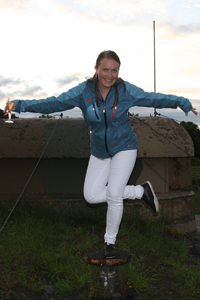The Galápagos Islands
The island of Santa Cruz was our first stop in the Galápagos archipelago. Here we visited Charles Darwin Research Station and learned more about the giant tortoises, Galápagos most famous inhabitants. After the visit to the research station we travelled up in the highlands and there we met the wild giant tortoises. On Santa Cruz we also saw the first marine iguanas and the red sally lightfoot crabs, which can be seen everywhere in the archipelago.

Sally lightfoot crab.

Sally lightfoot crab.

Marine iguana.

Giant tortoises.

A rare species of giant tortoise.
Santa Fé was our next stop. This island is one of the oldest in the archipelago. Here we met sea lions and land iguanas. I also had the best snorkelling experience ever here. I saw a white tip reef shark chasing a sea lion when I was snorkelling, and I was so lucky and managed to capture the moment with my underwater camera. Just before the camera broke down...

Sea lion babies.

Land iguana.

Land iguana.

A white tip reef shark chasing a sea lion!

Green turtle.
The cruise continued to South Plaza, but before we arrived there a frigate bird came to greet us and landed on top of one of the cranes onboard the ship.

Frigate bird.

A gull with its' chick.

Outside the shoreline of San Cristóbal you can find two vertical cliffs known as Kicker Rock or León Dormido, "the sleeping lion". Before we landed on San Cristóbal we went snorkelling around Kicker Rock.

Kicker rock in the horizon.

On the beach with the sleeping sea lions.

Lava gull.
On the island of Española we met colourful marine iguanas. Here the marine iguanas have a reddish skin. Between March and December Española lodge a colony of waved albatrosses. Majestic birds! We also met some funny looking blue-footed boobies here.

Marine iguana.

Waved albatross.

Waved albatrosses.

Waved albatrosses.

Blue-footed booby.
Sombrero Chino, the "chinese hat" got its' name because the island resembles a hat. There were less animals and birds here, but we were lucky to see a lonely Galápagos penguin swimming close to the island! The northernmost species of penguins.

Sombrero chino.

A little lava lizard is climbing the sea lion mountain.


Galápagos penguin.
The island of Santiago is a barren lava island and almost the only things that grow here are lava cactuses. Impressive that they manage to survive in this lava landscape.

Tine is photographing a lava cactus.

Lava landscape.
The island of Genovesa is home to thousands of birds. The island is sometimes called booby island, because of the many boobies which are living here. We saw both red-footed boobies and nazca boobies. The red footed boobies live up in the trees and it looks a bit strange to see birds with webbed feet cling to the branches.

Red-footed booby.

A nazca booby with its' chick.
This was a rather short summary of an amazing trip to a true paradise on earth! I spent one week cruising around in the Galápagos archipelago and visited a number of islands and landing sites, but there are still more places to discover and I hope I will come back one day!

Comments
Trackback


